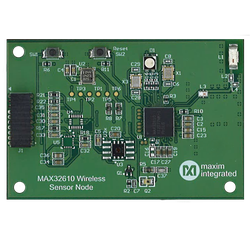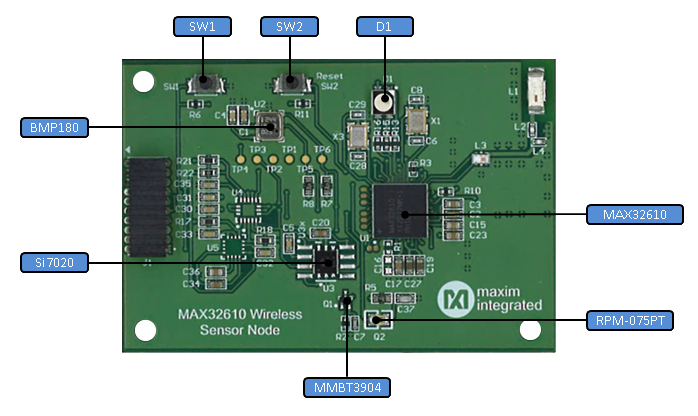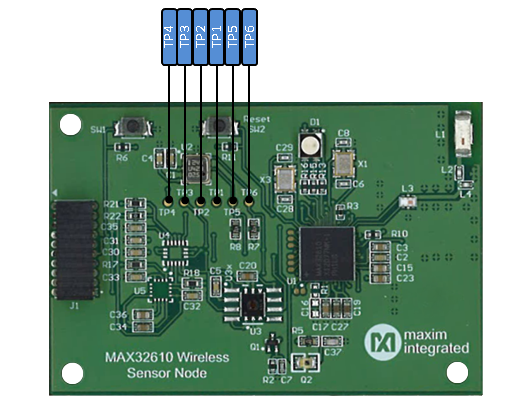MAXWSNENV
The MAXWSNENV provides a convenient platform evaluating the capabilities of the Environmental Sensor version of Maxim’s Wireless Sensor Node (WSN). The kit provides an excellent foundation for Internet of Things (IoT) applications.

End of Life Notice
Please note that this platform is no longer purchasable. Check out the other platforms from Maxim Integrated for your embedded systems design needs.
Features and Benefits¶
- Microcontroller plus BLE Transceiver provides a convenient development platform
- On-board sensors for Temperature, Ambient Light, Humidity and Barometric Pressure measures environmental data
- Low-power operation extends battery life
- ARM mbed compatible HDK interface provides quick connection to toolchain
- General purpose pushbutton switch and tri-color LED allow for real time input and feedback
- On-board battery holder provides convenient and replaceable power source
Kit Contents¶
- MAXWSNENV Environmental Sensor Board with pre-programmed demo
- MAXHDK, ARM mbed HDK compatible hardware development board
- USB Standard A-to-Micro-B cable (for connecting MAXHDK to PC)
- Coin-Cell Battery
Detailed Description¶
This section describes each major function or component on the MAXWSNENV board. This demo kit it is general purpose in nature, however, the included sensors allow for the development of sophisticated Wireless Sensor Network and IoT nodes.
The MAXWSNENV board should be used with the following documents:
- MAXWSNENV Data Sheet
- MAX32600 Data Sheet
- MAX32600 User Guide
- MAXWSNENV Schematic
- MAXWSNENV Bill-of-materials
Each of these is a separate document. Please access the latest version of the documents.
Microcontroller¶
The MAX32600 is a low-power, mixed-signal microcontroller with a variety of applications, including integration in wearable medical devices.
- ARM® Cortex®-M3 32-bit RISC CPU operating at up to 24MHz
- 256KB of flash memory
- 32KB of SRAM,
- 2KB instruction cache
- Integrated AFE Enables Precision Wellness Measurements with Minimal Discreets
- 16-Bit ADC with Input Mux and PGA Up to 500ksps Conversion Rate
- Programmable Buffers for ADC and DACs
- Two 12-Bit DACs and Two 8-Bit DACs
- Four Operational Amplifiers
- Four Low-Power Comparators
- Four Uncommitted SPST Analog Switches
- Trust Protection Unit for End-to-End Security
- USB Device Interface
- 6-Channel DMA Engine Enables Intelligent Peripheral Operation While Micro is in Sleep Mode
- Four 32-Bit Timers, Configurable to 8 x 16-Bit
- 32-Bit Real-Time Clock
- SPI Masters
- UARTs
- I2C Master Ports
- I2C Slave Port
- Up to 64 GPIO Pins with External Interrupt and Wake from Low-Power Mode
- Pulse Train Engine with Eight Digital Output Channels
Board Power¶
The demo board is powered by on-board coin-cell battery or by a connected and powered MAXHDK.
Bluetooth Low Energy (BLE) controller¶
The Bluetooth Low Energy controller is Bluetooth V4.0 compliant.
Sensors¶
The MAXWSNENV is fitted with four environmental sensors. Digital sensors are connected to the MAX32600 I2C master interface. Analog sensors are connected to the MAX32600 ADC interface. The MAXWSNENV includes the following sensors.
- BMP180 Pressure sensor, BMP180 Product Page and BMP180 Device Driver
- SI7020-A10 Humidity sensor, Si7020 Product Page and Si7020 Device Driver
- RPM-075PTT86 Phototransistor
- NPN Diode temperature sensor
Pushbuttons¶
Pushbutton SW1 can be used to generate an input for test purposes on port pin P1.5. SW1 is normally-open and therefore provides a logic 0 when depressed. Firmware defines the action taken on this switch closure.
Pushbutton SW2 provides a Power-On-Reset function to the MAX32600 microcontroller.
USB¶
The MAXWSNENV Board provides access to the MAX32600 USB D+ and D- signals on connector J1 pins 16 and 18 respectively.
LEDs¶
A single, tri-color LED with series resistors is connected to GPIO pins P1.4, P1.6 and P1.7.
MAXWSNENV and Maxim Epsilon HDK¶

MAXWSNENV sensor locations¶

MAXWSNENV test point locations¶


